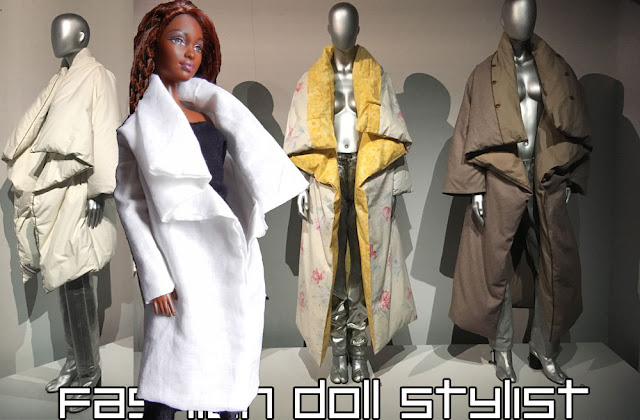 |
| "Recoup" A gown is belted and worn as a skirt. The lining is pulled out and worn as a top |
Considered one of the most atypical and mysterious designers of his generation, Martin Margiela with his conceptual collections, his predilection for deconstruction and recycled materials, his catwalk shows staged at unusual venues (warehouses, car parks, a metro station even a waste land site) quickly became one of the most talked about and the most imitated designers of his generation. He never made a single public appearance nor did he give personal interviews. Instead, journalists were responded to by fax in the first person plural as a gesture of respect to his team and as a statement in response to the celebrity cults dominating the fashion world at that time. As a reaction to the rise (and importance) of the supermodel, Margiela often covered the faces of girls in his shows. In 1988 Margiela set out on his own and launched a totally new movement which not only challenged the existing system but completely changed the course of fashion itself. “Grunge” otherwise known as ripped jeans, repurposed vintage clothes, deconstruction (garment linings and lingerie introduced as outerwear), rough cut hems, the helter-skelter of mixing patterns and prints…most of what we see on the streets of today can be attributed to this rebel. Don’t get me wrong! Me and my girls are NOT….repeat…NOT fans of grunge! So when we arrived in Paris only to learn there were—not one, but two exhibitions devoted to Martin Margiela, the man I feel launched the “anti-fashion,” grunge movement of the 1990’s, we found ourselves a bit perplexed.
 |
| Scavaging style. Existing garments are reconstructed into "new clothes. |
“Martin Margiela: 1989-2009” currently on at the Palais Galliera, is the first retrospective in Paris devoted to Margiela. It examines the designer’s conceptual approach in challenging the aesthetics of his time. His anti-1980’s movement is the starting point—deconstructed garments he recuperated from vintage shops then put back together with the seams on the outside. With the help of 100 garments accompanied by catwalk videos and installations, visitors are led through the evolution of his twenty year career. The intimate installations throughout the museum provides an up close and personal look at how Margiela constructed garments by deconstructing them, exposing the lining and other unfinished parts, thus revealing the different stages of manufacture: pleats, shoulder pads, patterns, bastings and all.
The designer thinks of new ways to wear clothes and new materials like the shirt and dress (left) which are made from stockings.
 |
| Margiela often transformed recuperated items and objects into works of fashion. Here, gloves are stitched together into a bustier. |
 |
| The down comforter coat. One basic coat with the option of changing the "cover" |
Margiela loved to use vintage scarves for his dresses.
 |
| Long before Kanye West's Yeezy stocking boots, Margiela had already created them. |
 |
| The beginning of the ripped jeans craze! |
Within his 20 year career, Margiela was commissioned to design ten womenswear collections for the 132 year old prestigious house of Hermes. From 1997 to 2003, Margiela developed a vision in which the woman’s way of living standards was essential to the design of the garment. For the Hermes woman, Margiela developed a gradually evolving wardrobe made up of individual pieces that contributed to the comfort, quality and timelessness of the basic look. He presented his collections on "real women" of varying images and body types as his fashions were always harmonized with the wearer.
 |
| Two looks in one thanks to the addition of an overskirt. |
 |
| It's Martin Margiela but classically executed for Hermes. |
What first may seem to be irreconcilable worlds of luxury and avant garde, are brought together as part of a single vision, in which ideas and concepts that span collection and seasons are recaptured, rethought, or even refined. For me, here is where I could best appreciate the talent of a man I had previously dismissed. Many of the concepts introduced in his own signature line were elaborated and refined for Hermes. Aesthetically, the silhouettes remain faithfully simple.
 |
| The stole jacket. Essentially a shawl or stole but with pockets that result in the look of a jacket! |
Both exhibitions provide an in-depth and well rounded look at a man who remained invisibly in the background of his work. They also yield a few very interesting items—Margiela’s “flat” garments--that I found useful for my girls. Okay, they won’t be wearing grunge anytime soon, but they did see a few things they found quite intriguing. In my next post, I will be following up with a “Behind the Design” post to show you what I found interesting and how I adapted it for my dolls.
“Martin Margiela: 1989-2009” Musée de la Mode de la Ville de Paris (Palais Galliera). 10, avenue Pierre-Ier-de-Serbie 75116 Paris www.palaisgalliera.paris.fr Entry : 10 Euros. Open Tues-Sun 10am-6pm (Thurs until 9pm) through July 15.
“Margiela: Les annees Hermes. Musee des Arts Decoratifs. 107, rue de Rivoli, 75001 Paris. www.lesartsdecoratifs.fr Entry : 11 Euros. Open Tues-Sun 11am-6pm (Open Thurs until 9pm) through September 2.
Follow us on Twitter: @FashDollStylist
Like us on Facebook: @FashDollStylist
We're also on Pinterest: @FashDollStylist
And of course, we are on Instagram: @fashiondollstylist
Like us on Facebook: @FashDollStylist
We're also on Pinterest: @FashDollStylist
And of course, we are on Instagram: @fashiondollstylist












0 nhận xét:
Đăng nhận xét